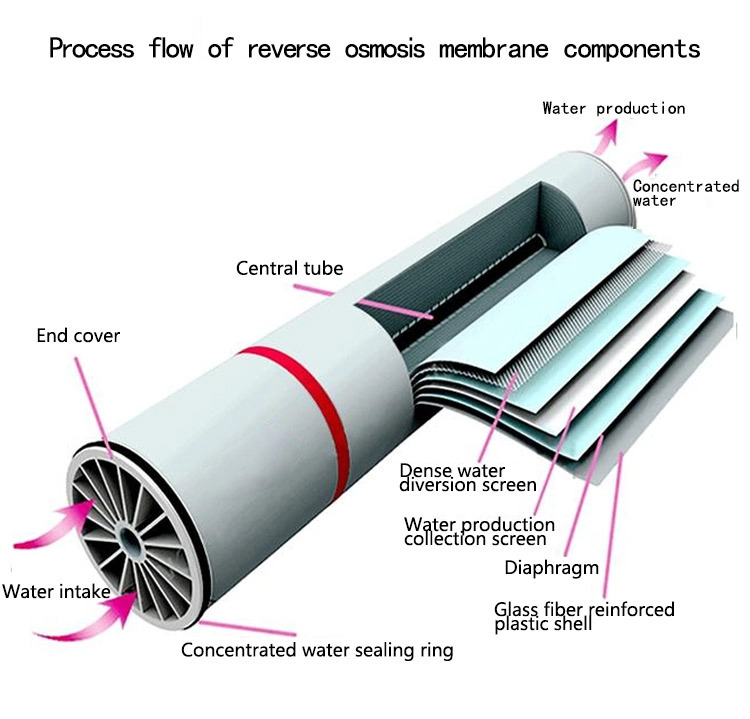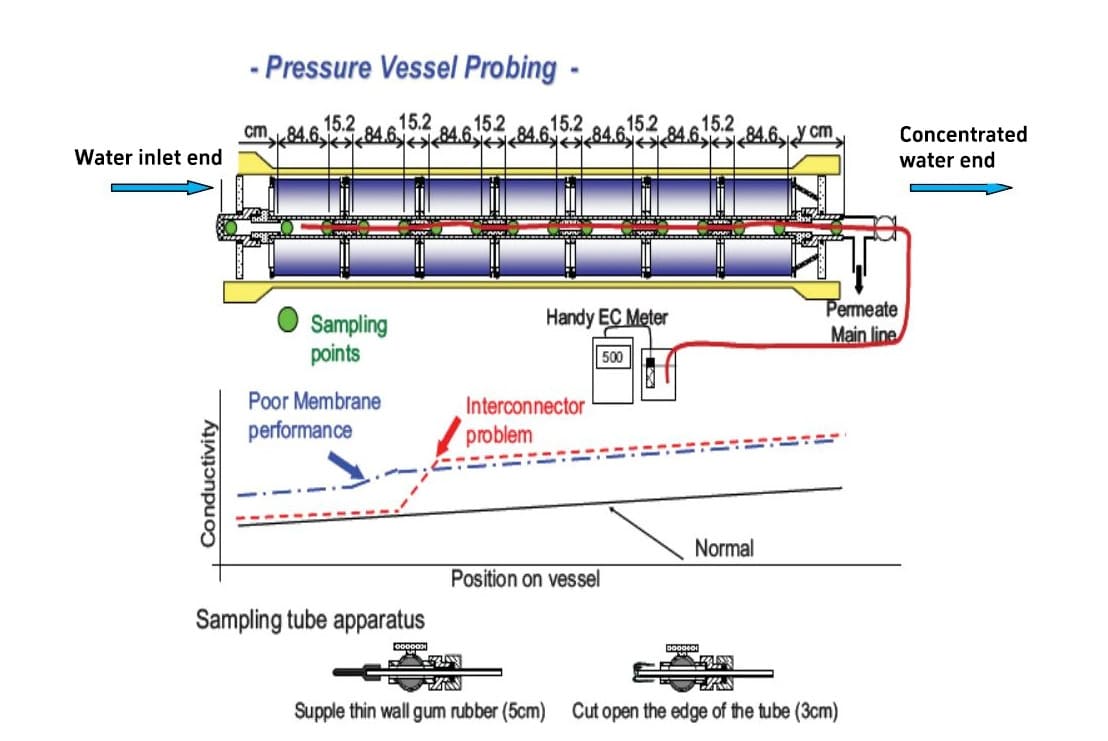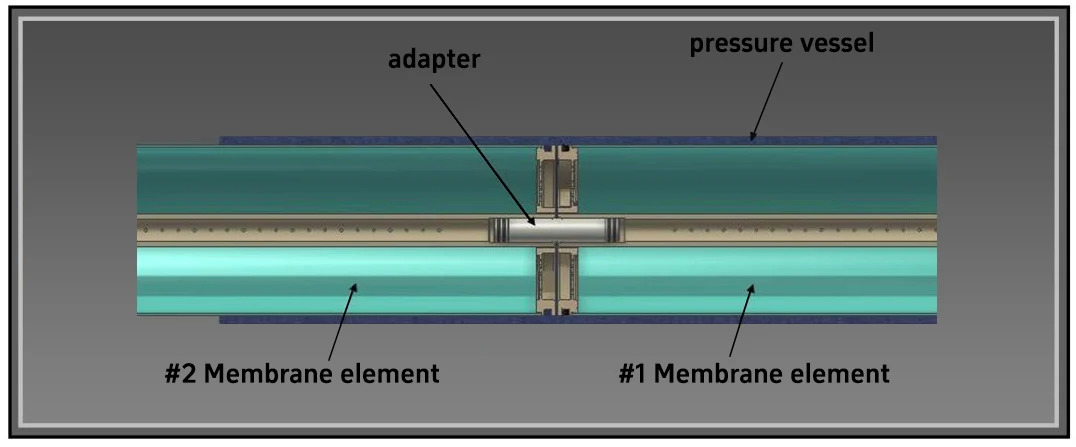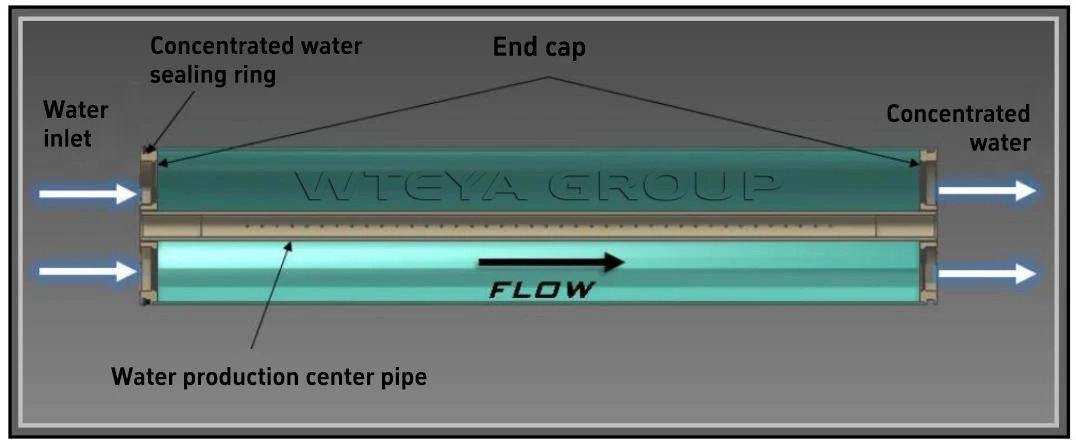RO Membrane 8040: High-Efficiency Water Filtration
Menu
Latest News
Product introduction
Reverse osmosis membrane 8040 introduction
In modern water treatment technology, reverse osmosis membrane 8040 has become an effective means to filter impurities in water with its fine pore size. This advanced separation technology is widely used in key areas such as research, the food and beverage industry, and seawater desalination. The reverse osmosis membrane 8040 is specially designed with a nanoscale pore size, which allows water molecules to pass smoothly while blocking contaminants such as inorganic salts, heavy metal ions, organic matter, colloidal particles, bacteria and viruses in the source water.
As the core component of water purification, the reverse osmosis membrane 8040 has a pore size as small as 0.0001 micron, and can effectively intercept impurities such as bacteria, viruses, heavy metal ions and organic molecules in the water. Its working principle is based on pressure drive, by allowing only water molecules to pass through, trapping pollution, resulting in high purity water. Due to its excellent performance, reverse osmosis membrane 8040 is not only widely used in home water purifiers, but also in public water supply systems and industrial wastewater treatment.
Structurally, the reverse osmosis membrane 8040 is the crystallization of a precision process, and the common components include the two end caps, the center tube, the O-ring seal, the membrane element itself, and the separation grid of the inlet and outlet water. These components work together to ensure that raw water can be effectively filtered through the membrane at the right pressure. The standard diaphragm is usually composed of three layers: a non-woven layer to provide support, a polysulfone intermediate layer, and a desalting layer with selective filtration. For some membrane elements that require higher functions, an additional layer of functional modification is also coated on the surface.
Reverse osmosis membrane 8040 features include:
1. The separation process needs to be carried out in a high pressure environment, so the system will be equipped with a special high pressure pump and pipeline. Nevertheless, the entire separation process has a relatively low energy consumption and can be done at room temperature, making it ideal for the separation and concentration of heat-sensitive substances.
2. It can efficiently remove dissolved salts, microorganisms and organic pollutants from water, especially for water with high salt content.
3. It has excellent desalting effect and water resource recovery rate, which plays an important role in saving water resources.
4. Simple equipment design, easy to achieve automated operation and maintenance.
5. Membrane contamination may occur during operation, and regular cleaning and maintenance are necessary.
6. In order to reduce the risk of membrane contamination, strict pretreatment of raw water entering the system is the standard process to ensure that the water quality meets the standard for entering the reverse osmosis membrane 8040.
The reverse osmosis membrane 8040, with its superior purification capacity and wide range of application scenarios, has become an indispensable technology choice in many water treatment projects.
Technical principle of
Reverse osmosis treatment unit, treatment principle is under the control of pressure, so that permate water from the reverse osmosis membrane pass through to retractable water, While the salt can't go through and a small amount of organic substances will be retained in concentrate liquid.
The technical principle of reverse osmosis membrane is mainly based on two basic physical processes: osmosis and reverse osmosis. During osmosis, due to the appearance of gradient concentration, natural water flows from low-concentration solution to high-concentration solution through semi-seepage solution to dilute high-concentration solution. And in the reverse osmosis process, by applying higher pressure than its osmosis pressure on one side of high concentration solution, reversible flow water molecules, flow from high-concentration solution to low-concentration solution, To achieve the purity.
RO membrane filtration function is very strong. When water flows through the membrane, most of the inorganic salt, the organic material is soluble in the water and bacteria, virus and other creatures can't pass through this membrane and are retained efficiently. And, because the diameter of the water molecules is smaller than the RO membrane aperture, they can pass smoothly, thereby reaching the purpose of separation and purity. This process is not related to chemical changes, no auxiliary product generating and is thus considered a safe and efficient water treatment.
The RO film's features also include electrolysis spraying ability to exceptionally reduce water hardness, and the elimination rate is usually more than 90%, very important for hard water areas. In addition, the membrane life is relatively long, can be used for years under precision maintenance, higher sex price.
In the application, the RO membrane is not only widely used for household and commercial water purification, but also used in many areas such as salt purification, recycling waste water and reuse. Its appearance greatly improved access to clean water, human safety and play an important role in improving global water shortage and ensuring safe water quality. With the development of material science and film technology, the reverse osmosis membrane performance is improved and its unique value will be displayed in many more areas in future.
The production process of


Production of equipment

Capacity and size
|
Parameter chart of RO elements |
||||
|
Film element model |
Standard % salt filtration rate |
Through the water volume gpd (m³/d) |
Active Film area of FT2 (square meter) |
Water supply channel width (Mil) |
|
ME-8040HR |
99.6 |
13,000 (49.3) |
400 (37) |
34 |
|
ME-8040FR |
99.7 |
10,100 (38.5) |
400 (37) |
34 |
|
ME-8040SW |
99.7 |
6,700 (25.5) |
400 (37) |
34 |
Chart of effect chart


Frequently Asked Questions
Q: What's RO membrane?
Re: reverse osmosis membrane is a very small aperture filter, able to separate water molecules from solution with high pressure, and prevent most soluble salts, bacteria, virus, and other impurities from going through.
Q: How does the RO membrane work?
Re: reverse osmosis membrane uses reverse osmosis and osmosis principle, when the pressure is higher than the natural osmosis pressure applied, water molecules will flow back through semi-Seeed films to separate pure water.
Q: What contaminants can be trimmed by RO membrane?
Re: Ro film can remove bacteria, virus, heavy metal ions, soluble salt, organic agents and some water-soluble chemicals.
Q: How long RO membrane should be replaced?
Re: different RO membrane replacement cycle depending on frequency of use and water quality condition, replacement is usually recommended every 2 to 5 years, specific to manufacturer's instructions and actual use it for identification.
Q: What is the filtration rate of RO membrane?
Re: Ro film usually has a salt filtration rate above 90%, which means it is effective in reducing hardness and salinity in the water.
Q: How do reverse osmosis membrane require water pressure?
Re: RO system usually requires a certain water pressure to normal operation, this pressure range usually varies from 40 to 60 psi (square pounds).
Q: How to wash and care RO membrane?
Re: Ro film cleaning and care regularly include steps like frequent washing, backwash and rinse chemical to eliminate dirt and grow bacteria on the film surface.
Q: What is the application of RO membrane?
Re: the RO membrane is widely used in home and commercial drinking water purification, public water supply system, the use of water in medical and pharmaceutical industry, industrial filtration and sewage treatment, etc. V. T.







